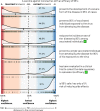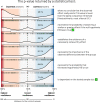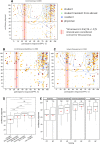Illusion of knowledge in statistics among clinicians: evaluating the alignment between objective accuracy and subjective confidence, an online survey
- PMID: 37081292
- PMCID: PMC10118231
- DOI: 10.1186/s41235-023-00474-1
Illusion of knowledge in statistics among clinicians: evaluating the alignment between objective accuracy and subjective confidence, an online survey
Abstract
Healthcare professionals' statistical illiteracy can impair medical decision quality and compromise patient safety. Previous studies have documented clinicians' insufficient proficiency in statistics and a tendency in overconfidence. However, an underexplored aspect is clinicians' awareness of their lack of statistical knowledge that precludes any corrective intervention attempt. Here, we investigated physicians', residents' and medical students' alignment between subjective confidence judgments and objective accuracy in basic medical statistics. We also examined how gender, profile of experience and practice of research activity affect this alignment, and the influence of problem framing (conditional probabilities, CP vs. natural frequencies, NF). Eight hundred ninety-eight clinicians completed an online survey assessing skill and confidence on three topics: vaccine efficacy, p value and diagnostic test results interpretation. Results evidenced an overall consistent poor proficiency in statistics often combined with high confidence, even in incorrect answers. We also demonstrate that despite overconfidence bias, clinicians show a degree of metacognitive sensitivity, as their confidence judgments discriminate between their correct and incorrect answers. Finally, we confirm the positive impact of the more intuitive NF framing on accuracy. Together, our results pave the way for the development of teaching recommendations and pedagogical interventions such as promoting metacognition on basic knowledge and statistical reasoning as well as the use of NF to tackle statistical illiteracy in the medical context.
Keywords: Calibration; Conditional probabilities; Decision-making; Discrimination; Medical context; Metacognition; Natural frequencies; Overconfidence bias; Sensitivity; Statistical illiteracy.
© 2023. The Author(s).
Conflict of interest statement
The authors declare that they have no competing interests.
Figures






Similar articles
-
A metacognitive confidence calibration (MCC) tool to help medical students scaffold diagnostic reasoning in decision-making during high-fidelity patient simulations.Adv Physiol Educ. 2023 Mar 1;47(1):71-81. doi: 10.1152/advan.00156.2021. Epub 2022 Aug 18. Adv Physiol Educ. 2023. PMID: 35981722
-
Metacognitive hindsight bias.Mem Cognit. 2020 Jul;48(5):731-744. doi: 10.3758/s13421-020-01012-w. Mem Cognit. 2020. PMID: 31989482
-
The effect of clinical experience, judgment task difficulty and time pressure on nurses' confidence calibration in a high fidelity clinical simulation.BMC Med Inform Decis Mak. 2012 Oct 3;12:113. doi: 10.1186/1472-6947-12-113. BMC Med Inform Decis Mak. 2012. PMID: 23034048 Free PMC article.
-
How to measure metacognition.Front Hum Neurosci. 2014 Jul 15;8:443. doi: 10.3389/fnhum.2014.00443. eCollection 2014. Front Hum Neurosci. 2014. PMID: 25076880 Free PMC article. Review.
-
[Characteristics and impact of metacognitive deficits in schizophrenia].Encephale. 2013 Apr;39(2):123-9. doi: 10.1016/j.encep.2012.01.009. Epub 2012 Dec 6. Encephale. 2013. PMID: 23219408 Review. French.
Cited by
-
Assessing statistical literacy in medical students and doctors: a single-centre, cross-sectional survey in South Korea.BMJ Open. 2025 Apr 7;15(4):e095173. doi: 10.1136/bmjopen-2024-095173. BMJ Open. 2025. PMID: 40194877 Free PMC article.
-
Skills Acquisition and Engagement with the Use of a Structured Journal Club Curriculum.Acad Psychiatry. 2025 Apr;49(2):147-151. doi: 10.1007/s40596-024-02079-2. Epub 2024 Oct 24. Acad Psychiatry. 2025. PMID: 39446299
-
Moving on From Self-assessment.PRiMER. 2024 Jan 23;8:5. doi: 10.22454/PRiMER.2024.624901. eCollection 2024. PRiMER. 2024. PMID: 38406231 Free PMC article.
-
Shifting Towards Teaching How to Communicate Statistics in Medical Education.J Med Educ Curric Dev. 2025 Feb 24;12:23821205241279751. doi: 10.1177/23821205241279751. eCollection 2025 Jan-Dec. J Med Educ Curric Dev. 2025. PMID: 39995618 Free PMC article.
-
Adaptive clinical trials in surgery: A scoping review of methodological and reporting quality.PLoS One. 2024 May 28;19(5):e0299494. doi: 10.1371/journal.pone.0299494. eCollection 2024. PLoS One. 2024. PMID: 38805454 Free PMC article.
References
-
- Baden LR, El Sahly HM, Essink B, Kotloff K, Frey S, Novak R, Diemert D, Spector S, Nadine Rouphael C, Creech B, McGettigan J, Khetan S, Segall N, Solis J, Brosz A, Fierro C, Schwartz H, Neuzil K, Corey L, Gilbert P, Janes H, Follmann D, Marovich M, Mascola J, Polakowski L, Ledgerwood J, Graham BS, Bennett H, Pajon R, Knightly C, Leav B, Deng W, Zhou H, Han S, Ivarsson M, Miller J, Zaks T. Efficacy and safety of the mRNA-1273 SARS-CoV-2 vaccine. New England Journal of Medicine. 2021;384(5):403–416. doi: 10.1056/NEJMoa2035389. - DOI - PMC - PubMed
Publication types
MeSH terms
LinkOut - more resources
Full Text Sources
Miscellaneous
